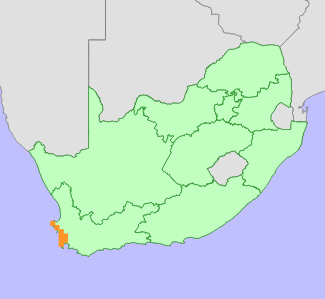|
Scientific Name | Aspalathus lotoides Thunb. subsp. lotoides |
Higher Classification | Dicotyledons |
Family | FABACEAE |
Synonyms | Aspalathus heterophylla L.f. subsp. lotoides (Thunb.) R.Dahlgren, Aspalathus procumbens E.Mey., Paraspalathus humifusa C.Presl, Paraspalathus lotoides (Thunb.) C.Presl, Paraspalathus procumbens (E.Mey.) C.Presl |
National Status |
Status and Criteria | Vulnerable B1ab(i,ii,iii,iv,v)+2ab(i,ii,iii,iv,v) |
Assessment Date | 2018/10/04 |
Assessor(s) | D. Raimondo, N.A. Helme & L. von Staden |
Justification | Aspalathus lotoides subsp. lotoides has a restricted range, with an extent of occurrence (EOO) of 2641 km², and an area of occupancy (AOO) of less than 700 km². Between four and 10 locations remain. It is threatened across its range by ongoing habitat loss to coastal development and competition from alien invasive plants. It is therefore listed as Vulnerable under criterion B. |
Distribution |
Endemism | South African endemic |
Provincial distribution | Western Cape |
Range | This taxon is endemic to a small area of the Western Cape's coastal lowlands in South Africa, where it is found from the Vredenburg Peninsula to Darling and the Cape Peninsula. |
Habitat and Ecology |
Major system | Terrestrial |
Major habitats | Saldanha Granite Strandveld, Swartland Granite Renosterveld, Peninsula Granite Fynbos, Hangklip Sand Fynbos, Cape Flats Sand Fynbos, Atlantis Sand Fynbos, Hopefield Sand Fynbos |
Description | It occurs in loamy sands associated with granites close to the coast and on marine sand. |
Threats |
| Many subpopulations known through historical records are now extinct due to urban expansion on the Cape Peninsula and Cape Flats. Further north, on the sandy plains around Mamre and Atlantis, remaining subpopulations are threatened by competition from dense infestations of alien invasive plants. It has also lost habitat to coastal development around Langebaan and Jacobsbaai. |
Population |
Based on historic collections, this species used to be common on the Cape Peninsula, but it has not been recorded at most localities since 1945. It was recently (2011) confirmed that it is still present at Rondebosch Common on the Cape Flats. This species is known from a large number of historical records, but has been confirmed present at only four locations in the past 15 years, in spite of extensive survey efforts by volunteer members of the Custodians of Rare and Endangered Wildflowers (CREW).
Intact habitat remains at six locations known through historical records, and the species may still be relocated at these. A continuing decline is inferred from ongoing habitat loss and degradation.
|
Population trend | Decreasing |
Assessment History |
Taxon assessed |
Status and Criteria |
Citation/Red List version | | Aspalathus lotoides Thunb. subsp. lotoides | VU B1ab(i,ii,iii,iv,v) | Raimondo et al. (2009) | |
Bibliography |
Dahlgren, R. 1960. Revision of the genus Aspalathus. I. The species with flat leaflets. Opera Botanica 4:7-393.
Dahlgren, R. 1988. Crotalarieae (Aspalathus). In: O.A. Leistner (ed). Flora of southern Africa 16 Fabaceae, Part 3 Papilionoideae, Fascicle 6:1-430. National Botanical Institute, Pretoria.
Raimondo, D., von Staden, L., Foden, W., Victor, J.E., Helme, N.A., Turner, R.C., Kamundi, D.A. and Manyama, P.A. 2009. Red List of South African Plants. Strelitzia 25. South African National Biodiversity Institute, Pretoria.
|
Citation |
| Raimondo, D., Helme, N.A. & von Staden, L. 2018. Aspalathus lotoides Thunb. subsp. lotoides. National Assessment: Red List of South African Plants version 2024.1. Accessed on 2025/10/26 |
 Comment on this assessment
Comment on this assessment


